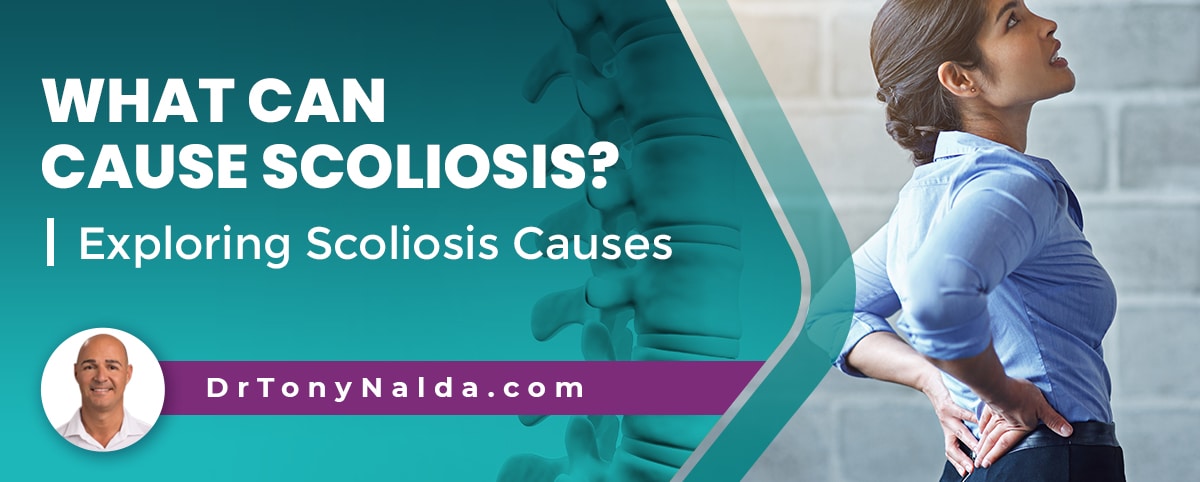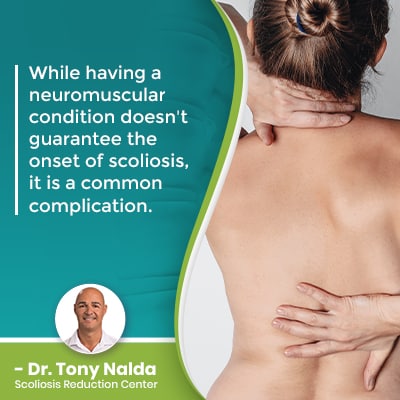What Can Cause Scoliosis? Exploring Scoliosis Causes

Scoliosis is a highly-prevalent structural spinal condition that can be complex to treat. Not only does scoliosis range from mild to moderate and severe to very severe, it also has different condition types, determined by causation. Continue reading to learn more about the different causes of scoliosis.
Scoliosis ranges in severity, and there are also different types of scoliosis. In the majority of cases, scoliosis is idiopathic, meaning we don't know why it developed. The remaining types have known causes: neuromuscular scoliosis, congenital scoliosis, and degenerative scoliosis.
To better understand the condition, let's first discuss the guidelines that have to be met to reach a scoliosis diagnosis.
Table of Contents
Diagnosing Scoliosis
There are many different spinal conditions a person can develop over a lifetime, many of which involve a loss of the spine's healthy curves, so certain guidelines have to be met in order to be considered a true scoliosis.
Scoliosis is the development of an unnatural sideways spinal curvature that also rotates (twists) and has a minimum Cobb angle measurement of 10 degrees.
A patient's Cobb angle is a key piece of information; not only does it tell me how far out of alignment a scoliotic spine is, it also classifies conditions by severity:
- Mild scoliosis: Cobb angle measurement of between 10 and 25 degrees
- Moderate scoliosis: Cobb angle measurement of between 25 and 40 degrees
- Severe scoliosis: Cobb angle measurement of 40+ degrees
- Very-severe scoliosis: Cobb angle measurement 80+ degrees
The more severe the condition, the more likely it is that its symptoms will be noticeable, and the larger the unnatural spinal curve, the more likely it is to increase over time; this is due to the condition's progressive nature.
There are two main scoliosis treatment approaches for patients to choose between, traditional and conservative, and as a progressive and complex condition, committing to a treatment approach is the most important decision as they offer different potential outcomes.
Traditional treatment doesn't have a strategy for mild scoliosis treatment, so patients are commonly told to watch and wait, until progression has occurred, making the condition severe, and the patient a surgical candidate.
Fortunately, the reality is that most cases of scoliosis can be treated non-surgically, which is where modern proactive conservative treatment with proven results.
So in addition to condition severity, part of the diagnostic process involves further specifying conditions based on patient age, curvature location, and the cause of scoliosis.
Different Condition Types/Causes of Scoliosis
Scoliosis can affect all ages, and the most common type to affect both adults and children is called idiopathic scoliosis, which means it's not clearly associated with a single-known cause; now, this isn't the same as a complete absence of a cause.
Idiopathic Scoliosis
The general consensus regarding idiopathic scoliosis is that it's a multifactorial condition, meaning caused by multiple factors that can vary from person to person.
There is no shortage of theories regarding the etiology of idiopathic scoliosis from genetics to hormones, bone formation issues, vitamin deficiency, musculoskeletal and skin diseases, low body mass index, and many more.
So as you can see, there are a number of links between scoliosis and a wide range of potential causes, but many are more indirect than direct, and/or are more correlative than causative.
The most common type of idiopathic scoliosis is adolescent idiopathic scoliosis (AIS), diagnosed between the ages of 10 and 18, and some common symptoms of scoliosis in children are postural changes such as uneven shoulders, uneven shoulder blades with one shoulder blade protruding more on one side, muscle weakness, and the development of a rib cage arch.
Can Scoliosis be Caused by Bad Posture?
Many adolescents, recently diagnosed, ask if bad posture can cause the condition.
While bad posture can cause the development of what's known as functional scoliosis, this isn't considered a true scoliosis because there is no rotational component.
Functional scoliosis isn't a structural condition as there is no structural abnormality within the spine itself; its cause is temporary such as leg-length discrepancy (LLD) or chronic poor posture that, over time, stretches the spine's supportive ligaments.
With functional scoliosis, when an active effort is made to straighten the spine, the unhealthy curve improves; this is not the case with structural scoliosis.
Scoliosis is Progressive
As mentioned earlier, scoliosis is progressive, and while we don't always understand the condition's onset, we most certainly know how to treat it, and we do understand what triggers it to progress: growth and development.
So in cases of adolescent scoliosis, this age group is at risk for rapid-phase progression because of the stage of puberty: rapid and unpredictable growth spurts.
So where a scoliosis is at the time of diagnosis is not indicative of where it will stay; only treating scoliosis proactively can work towards counteracting the condition's progressive nature.
Now that we've addressed the most prevalent type of scoliosis without a clear cause, let's focus on the condition types associated with known causes: neuromuscular scoliosis, degenerative scoliosis, and congenital scoliosis.
Neuromuscular Scoliosis
 When it comes to cases of neuromuscular scoliosis(NMS), scoliosis is caused by the presence of a larger neuromuscular condition such as cerebral palsy, muscular dystrophy, and spina bifida.
When it comes to cases of neuromuscular scoliosis(NMS), scoliosis is caused by the presence of a larger neuromuscular condition such as cerebral palsy, muscular dystrophy, and spina bifida.
In most neuromuscular connective tissue disorders, there is a disconnect between the brain, the spine, and the spine's supportive muscles, ligaments, and/or connective tissues, which compromises the spine's ability to maintain its natural curves/alignment.
While having a neuromuscular condition doesn't guarantee the onset of scoliosis, it is a common complication.
Degenerative Scoliosis
Degenerative scoliosis is caused by natural age-related spinal degeneration that most often starts with the spine's intervertebral discs.
In a healthy spine, the vertebrae (bones of the spine) are stacked on top of one another, and adjacent vertebrae are separated by an intervertebral disc.
If a disc starts to deteriorate, it can become desiccated, a bulging, or a herniated disc, and as the discs provide the spine with structure (adjacent vertebrae attach to the disc in between), if a disc changes shape due to degeneration, this exposes adjacent vertebrae to uneven pressure, causing them to tilt unnaturally, and develop into a scoliotic curve.
Degenerative scoliosis is most common in adults over 40 and is more prevalent in females due to changes in bone density and hormones caused by menopause.
Congenital Scoliosis
Many times, I'm asked "Are you born with scoliosis?" The answer is you can be, if a condition is classified as congenital.
There is also infantile scoliosis, considered idiopathic, and this affects children from the age of 6 months to 3 years.
In cases of congenital scoliosis, infants are born with the condition due to a malformation within the spine that developed in utero; this can involve misshapen vertebrae that are more triangular in shape, than rectangular, and this causes them to wedge forward, forcing the spine out of alignment.
In addition, congenital scoliosis can be caused by vertebral bodies failing to separate into distinct bones, instead becoming fused together.
Cases of congenital scoliosis are rare, affecting approximately 1 in 10,000.
Conclusion
With the scoliosis research society estimating that there are close to seven million people living with scoliosis in the United States alone, and considering it's also the leading spinal condition amongst school-aged children, a lot of effort has been made to fully understand the condition's etiology.
So the cause of scoliosis will depend on the type of scoliosis in question.
Idiopathic scoliosis is the condition's most prevalent form; in fact, idiopathic scoliosis accounts for approximately 80 percent of known diagnosed cases, and the remaining 20 percent fall into the following categories, with known causation: neuromuscular, degenerative, and congenital scoliosis.
When it comes to treatment options for scoliosis, condition type is an important factor that shapes the design of effective treatment plans.
For those asking, can you give yourself scoliosis, the answer is no, not a true structural scoliosis; while a functional scoliosis can be caused by poor posture and a number of lifestyle factors, true scoliosis is structural in nature so involves a structural abnormality within the spine itself.
Here at the Scoliosis Reduction Center, I diagnose conditions by conducting a comprehensive physical examination that includes having the patient bend forward and conducting what's known as an Adam's forward bend test, taking the family history, considering risk factors, and checking to see if a visibly curved spine is present.
If my initial exam shows a number of condition indicators, this warrants the need for further testing, and this involves an X-ray so I can measure the patient's Cobb angle and really see what's going on in and around the spine.
As a progressive condition, when it comes to treating an unnatural curvature of the spine, I want to start treatment as close to the time of diagnosis as possible; although there are never treatment guarantees, being proactive can help prevent progression, escalating symptoms, and the need for invasive surgical treatment in the future.
So if you suspect scoliosis has developed, support and guidance is needed, and the best time to start treatment is always now.
Dr. Tony Nalda
DOCTOR OF CHIROPRACTIC
After receiving an undergraduate degree in psychology and his Doctorate of Chiropractic from Life University, Dr. Nalda settled in Celebration, Florida and proceeded to build one of Central Florida’s most successful chiropractic clinics.
His experience with patients suffering from scoliosis, and the confusion and frustration they faced, led him to seek a specialty in scoliosis care. In 2006 he completed his Intensive Care Certification from CLEAR Institute, a leading scoliosis educational and certification center.
About Dr. Tony Nalda
 Ready to explore scoliosis treatment? Contact Us Now
Ready to explore scoliosis treatment? Contact Us Now





